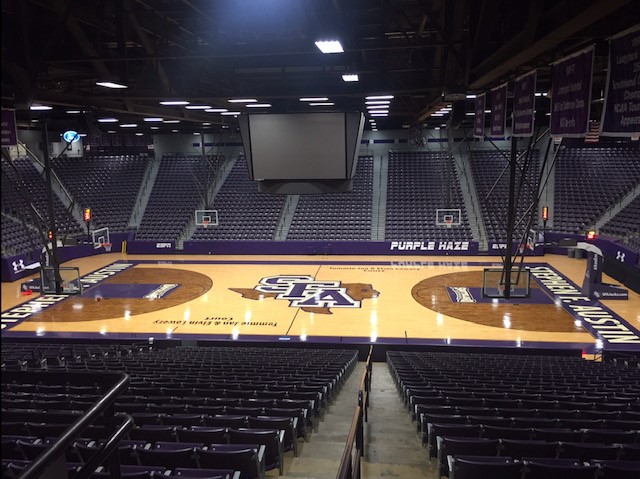Yesterday (5/19), the news broke via sources at ESPN and the communications department with Stephen F. Austin State University Athletics that the university’s athletic department would be facing sanctions from the NCAA regarding student athlete’s academic performances being improperly recorded since 2013, and findings have indicated that real scores would have left the program below the academic threshold the league has instituted.
APR, or Academic Progress Rate, is the meter by which member programs of the NCAA can quantify and measure academic success. This measure was put in place in 2004 as a means to maintain academic integrity across a league in which member organizations have a proven track record of being unable to fairly govern themselves in order to gain or maintain a competitive edge.
APR scores are released by the league annually near the end of the academic year, and while SFA has recently been touting their exceptionally high academic grades from their student athletes, it would appear that this has not entirely been the case over the past six years.
What is the APR and how is it calculated?
While the idea of a more contemporary and accurate measure of a team’s academic success sprouted in the early 2000s as part of a comprehensive reform effort, it wasn’t until the 2004 NCAA Convention that what is now one of the most recognizable acronyms in the NCAA was officially adopted.
The APR, or Academic Progress Rate, holds institutions accountable for the academic progress of their student-athletes through a team-based metric that accounts for the eligibility and retention of each student-athlete for each academic term.
The APR is calculated as follows:
- Each student-athlete receiving athletically related financial aid earns one point for staying in school and one point for being academically eligible.
- A team’s total points are divided by points possible and then multiplied by 1,000 to equal the team’s Academic Progress Rate.
- In addition to a team’s current-year APR, its rolling four-year APR is also used to determine accountability.
Teams must earn a four-year average APR of 930 to compete in championships.
–http://www.ncaa.org/about/resources/research/academic-progress-rate-explained

According to Ryan Ivey, Director of Athletics at SFA, the incident was the cause of a clerical error performed by compliance staff back in 2013 in which all transferable credits for athletes were counted into the equation, while only ‘degree-applicable” credits are supposed to be taken into account. Naturally, this discrepancy would have allowed for APR scores over the years to be incorrectly portrayed as higher than accurate data would have.
Regarding questions raised about foul play possibly being involved during a press conference via Zoom this afternoon, Director of Athletics Ryan Ivey stated “I want to make [it] clear that [Coaches are] not involved in the certification process in any way.”
Ivey went on to explain how the program discovered the APR error this time a year ago and have made consistent efforts to maintain transparency with the NCAA in order to ease negotiations and lighten sanctions, which it would appear they did successfully.
According to the university the Level I (Mitigated) sanctions agreed upon by the NCAA and Stephen F. Austin include the following:
- Three years of probation;
- Public reprimand and censure;
- A fine of $5,000 plus one-half of one percent of the total budgets for football and men’s basketball;
- The return of 50 percent of the University’s financial share earned from participation in the 2016 NCAA Tournament;
- The forfeiture of all records and contests in which an ineligible SFA student-athlete competed, which includes 29 football victories from 2013-2019; 117 men’s basketball victories from 2014 to 2019; 112 baseball victories from 2015 to 2019; 31 softball victories from the 2018 season; and adjusted conference championship scores from women’s golf, women’s track and field, men’s cross country and men’s track and field.
- Included in the vacation of wins are conference championships in men’s basketball in 2014-15, 2015-16 and 2017-18, as well as the program’s First Round win in the 2016 NCAA Tournament. The banners recognizing those achievements will be removed from William R. Johnson Coliseum.
- A 2.5% reduction in financial aid awards (scholarships) in football for 2020-2021 and 2021-2022; a 5% reduction in baseball in either 2020-21 or 2021-2022 and the loss of one scholarship in men’s basketball in either 2020-2021 or 2021-22.
- Prior to the conclusion of the probationary period, the institution will submit to a data review with APP staff.
An unfortunate reality of the situation is that now arguably the best half decade of the program’s history now has this ugly stigma attached to it; not to mention the fact that if the problem had originated in 2013 as reported, then an entirely different administration- one which didn’t yet include Ivey and two of the three head coaches whose programs are implicated in the low score findings. The SFA Athletics’ leadership structure currently in place- and their recruiting efforts- will have to suffer the transgressions of a previous administration before moving ahead on what arguably may be one of the quickest upward trajectories of any Mid-Major programs in the nation.










